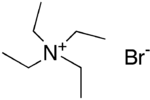Tetraethylammonium bromide
Tetraethylammonium bromide (TEAB) is a quaternary ammonium compound with the chemical formula C8H20N+Br−, often written as "Et4N+Br−" in the chemical literature. It has been used as the source of tetraethylammonium ions in pharmacological and physiological studies, but is also used in organic chemical synthesis.
 | |
| Names | |
|---|---|
| IUPAC name
Tetraethylammonium bromide | |
| Other names
Tetrylammonium bromide, TEA, TEABr | |
| Identifiers | |
3D model (JSmol) |
|
| ChEMBL | |
| ChemSpider | |
| ECHA InfoCard | 100.000.700 |
PubChem CID |
|
| UNII | |
CompTox Dashboard (EPA) |
|
| |
| |
| Properties | |
| C8H20NBr | |
| Molar mass | 210.16 g/mol |
| Appearance | White solid |
| Density | 1.4 g/cm3 |
| Melting point | 286 °C (547 °F; 559 K) (decomposes) |
| Soluble | |
| Hazards | |
| Safety data sheet | External MSDS |
| R-phrases (outdated) | R36 R37 R38 |
| S-phrases (outdated) | S26 S36 |
Except where otherwise noted, data are given for materials in their standard state (at 25 °C [77 °F], 100 kPa). | |
| Infobox references | |
Chemistry
Synthesis
TEAB is commercially available, but can be prepared by the reaction between tetraethylammonium hydroxide and hydrobromic acid:
- Et4N+HO− + HBr → Et4N+Br− + H2O
Evaporation of the water and recrystallization from acetonitrile yields a crystalline sample of TEAB.[1]
Structure
The crystal structure of TEAB has been determined and found to exhibit a distorted tetrahedral symmetry with respect to the geometry of the C atoms around the central N.[2]
Synthetic applications
Examples include:
- TEAB catalyzes the high-yield oxidation of organic sulfides to sulfoxides by o-iodoxybenzoic acid (IBX) in chloroform/water at room temperature,[3] e.g.
- (C2H5)2S → (C2H5)2S=O
- TEAB has been used for the in situ preparation of tetraethylammonium superoxide from potassium superoxide for the conversion of primary alkyl halides to dialkyl peroxides.[4] The overall reaction is:
- 2R1Br + 2KO2 → R1-O-O-R1 + 2KBr + O2
Biology
In common with tetraethylammonium chloride and tetraethylammonium iodide, TEAB has been used as a source of tetraethylammonium ions for numerous clinical and pharmacological studies, which are covered in more detail under the entry for tetraethylammonium. Briefly, TEAB has been explored clinically for its ganglionic blocking properties,[5] although it is now essentially obsolete as a drug, and it is still used in physiological research for its ability to block K+ channels in various tissues.[6]
Toxicity
The toxicity of TEAB is primarily due to the tetraethylammonium ion, which has been studied extensively. The acute toxicity of TEAB is comparable to that of tetraethylammonium chloride and tetraethylammonium iodide. These data, taken from a study by Randall and co-workers,[7] are provided for comparative purposes; additional details may be found in the entry for Tetraethylammonium.
LD50 for mouse: 38 mg/kg, i.v.; 60 mg/kg, i.p.; >2000 mg/kg, p.o.
References
- D. N. Kevill and N. H. Cromwell (1961). "Elimination reactions of α-halogenated ketones. V. Kinetics of the bromide ion promoted elimination reaction of 2-benzyl-2-bromo-4,4-dimethyl-1-tetralone in solvent acetonitrile". J. Am. Chem. Soc. 83 3812-3815.
- M. Ralle, J. C. Bryan, A. Habenschuss and B. Wunderlich (1997). "Low-temperature phase of tetraethylammonium bromide." Acta Crystallogr. Sect. C C53 488–490.
- V. G. Shukla, P. D. Salgaonkar and K. G. Akamanchi (2003). "A mild, chemoselective oxidation of sulfides to sulfoxides using o-iodoxybenzoic acid and tetraethylammonium bromide as catalyst." J. Org. Chem. 68 5422-5425.
- T. A. Foglia and L. S. Silbert (1992)."Preparation of di-n-alkyl peroxides: phase-transfer reaction of potassium superoxide with primary alkyl bromides." Synthesis 545-547.
- A. M. Boyd et al. (1948). "Action of tetraethylammonium bromide." Lancet 251 15-18.
- C. M. Armstrong and B. Hille (1972). "The inner quaternary ammonium receptor in potassium channels of the node of Ranvier." J. Gen. Physiol. 59 388-400.
- L. O. Randall, W. G. Peterson and G. Lehmann (1949). "The ganglionic blocking actions of thiophanium derivatives." J. Pharmacol. Exp. Ther. 97 48-57.